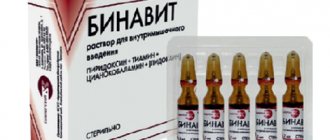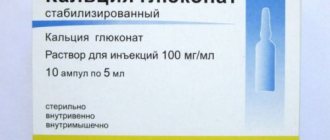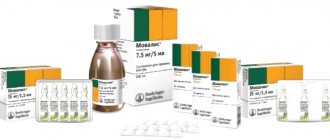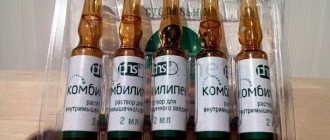Movalis is the best and most effective of the meloxicam drugs. This means that all other drugs containing meloxicam as a chemical compound came later, and Movalis was the leader, or the first original drug from Boehringer Ingelheim. Movalis is highly effective for spinal hernias; it reduces pain and allows the patient to regain freedom of movement.
How does Movalis work? Does it cure a hernia or not? How should it be used, what side effects might it have, and how much does this medicine cost? These and other questions will be answered in this material. This article is written in simple language and is intended for people without medical education.
Compound
The drug contains the active substance meloxicam , as well as the following auxiliary components:
Movalis tablets: sodium citrate, lactose monohydrate, MCC, povidone, anhydrous colloidal silicon dioxide, magnesium stearate, crospovidone.
Ingredients of the injections: meglumine, glycofurol, poloxamer 188, glycine, sodium hydroxide, sodium chloride, purified water.
Movalis suppositories: basis for the manufacture of suppositories suppositir BP, cremophor RH40 (polyethylene glycol glyceryl hydroxystearate).
Movalis suspension: colloidal silicon dioxide, hyaetellose, sorbitol , glycerol , xylitol; benzoate, saccharinate and sodium dihydrogen phosphate dihydrate; citric acid monohydrate, raspberry flavor, purified water.
Release form
The drug is available in:
- tablet form (active substance dosage 7.5 mg (package No. 20) and 15 mg (package No. 10 or No. 20));
- solution for injection 10 mg/ml (ampoules 1.5 ml, package No. 5);
- rectal suppositories 7.5 and 15 mg (package No. 6);
- suspension 1.5 mg/ml (100 ml bottle).
The tablets have a flat-cylindrical shape and beveled edges. One side is marked with the company logo, the other has a fault line. The color of the tablets is from pastel yellow to lemon yellow; roughness on the surface is allowed.
The solution is yellow with a greenish tint, transparent.
The suppositories are smooth, yellowish-green, and have a funnel-shaped depression at the base.
The suspension is a viscous substance of yellowish-green color.
The manufacturer does not produce external therapy products (ointment, gel).
Release form and dosage regimen
Since Movalis is the very first, most researched and safest of all meloxicams, the rest of the meloxicam medications, the so-called generics, or commercial copies, are equal to the flagship of the line - Movalis, and are produced in the same dosage and concentration.
Meloxicam is available as:
- solution for intramuscular use - injection solution 15 mg/1.5 ml, three ampoules or five ampoules in a package;
- tablets, tablets in the following dosages: 15 mg No. 10 or 20, 7 mg tablets package No. 10 and 20;
- suspension for oral administration - a 100 ml bottle, with 5 ml of suspension corresponding to one 7 mg tablet. The suspension is prescribed infrequently and is rarely available in pharmacies.
The presence of such dosage forms makes it possible to cover almost all routes of administration, and mainly ampoules and tablets are in demand in pharmacies. But how to start treatment for acute back pain?
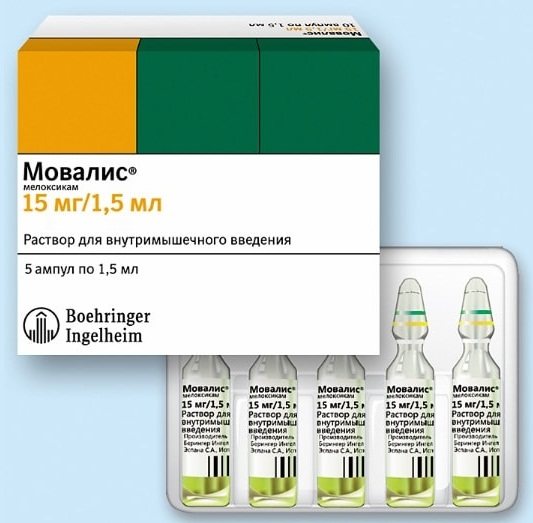
As already noted, in the article on drug treatment of hernias, first, on the first or second day, it is necessary to eliminate swelling, inflammation and relieve pain as quickly as possible. Therefore, it is necessary to administer Movalis intramuscularly, and then switch to tablets. There is a special package that contains three ampoules, especially for such a short, three-day course of treatment.
Subsequent intake of tablets is possible according to the following scheme: three days - 15 mg tablets, and another 3 days - 7 mg tablets. If the patient has a history of ulcers or exacerbation of gastritis, then just in case, it is advisable to prescribe proton pump inhibitors for prophylactic purposes while taking the drug. The standard is Omeprazole, one capsule 20 mg 2 times a day. This scheme will allow you to avoid exacerbation of gastric ulcers or exacerbation of erosive gastritis.
Of course, the use of Movalis requires complex therapy, together with the prescription of centrally acting muscle relaxants, vitamins, as well as the use of local remedies. But this will be discussed in other articles.
Pharmacodynamics and pharmacokinetics
Pharmacodynamics: what is Meloxicam and how does it work?
Wikipedia states that the mechanism of action of the drug is based on its ability to suppress the production of Pg. Its pronounced anti-inflammatory activity has been established in all standard models of inflammation.
In vivo, it suppresses the synthesis of Pg in the pathological focus to a greater extent than in the kidneys or in the gastric mucosa, which is associated with a more selective inhibition of the COX-1 isoenzyme compared to COX-2.
It is generally accepted that the therapeutic effectiveness of NSAIDs is due to the inhibition of COX-2, while the renal and gastrointestinal side effects of these drugs arise from the suppression of the constitutively present isoenzyme COX-1.
Selectivity for COX-2 has been confirmed in various tests, both in vitro and ex vivo. In ex vivo models, liposaccharide-stimulated production of PgE2, which is controlled by COX-2, was more actively suppressed than the production of thromboxane, which is involved in the hemocoagulation process, which is controlled by COX-1. The effects were dose-dependent.
It has also been shown in ex vivo models that, at recommended doses, the drug does not alter bleeding time or affect platelet . This fundamentally distinguishes Meloxicam from Ibuprofen , Indomethacin , Diclofenac and Naproxen .
Clinical studies have established that NSAID gastropathy develops significantly less frequently when taking Meloxicam than when taking other NSAIDs. Vomiting, abdominal pain, nausea, and dyspepsia were reported less frequently in patients taking Meloxicam than in patients taking other NSAIDs.
meloxicam- related upper gastrointestinal bleeding, perforation , and was low and dose-related.
Pharmacokinetics:
- absorption from the digestive canal is good, does not change with simultaneous food intake;
- bioavailability - 89% (when taken orally);
- TSmax for a single dose is 5-6 hours, during the period of steady state pharmacokinetic parameters (when taking Meloxicam in tablets and suspension form) - 5-6 hours;
- the time to achieve a steady state of pharmacokinetic parameters with repeated use is 3-5 days;
- binding to albumin (plasma proteins) - 99%; T1/2 (average) - 20 hours.
Dosing 1 r./day. leads to an average plasma concentration with slight fluctuations in peak values: for 7.5 mg within 0.4-1, for 15 mg - within 0.8-2 μg/ml (Cmax and Cmin during the period of steady state pharmacokinetic parameters).
Honey concentrations of the drug after systematic use for more than six months are similar to the concentrations observed after 14 days. oral dose 15 mg.
The pharmacokinetics indicators (Cmax, Cmin, TCmax) of Meloxicam in the form of suppositories are similar to those for tablets.
The drug penetrates well into the synovium.
Metabolism occurs in the liver. The resulting substances are pharmacologically inactive. Meloxicam is excreted equally in urine and feces, in pure form - up to 5% of the dose. Only trace concentrations of the pure substance are found in urine.
Indications for use of Movalis
What do pills help with?
Indications for use of tablets:
- symptomatic treatment of aggravated osteoarthritis ;
- long-term treatment of infectious nonspecific polyarthritis and rheumatoid spondylitis (reviews and numerous studies that were carried out in compliance with all requirements for drug testing confirm the effectiveness and good tolerability of Movalis, including its long-term use).
What are Movalis injections for?
Injections of the drug are prescribed for short-term treatment of an acute attack of infectious nonspecific polyarthritis or rheumatoid spondylitis , when the rectal and oral routes of administration of the drug Movalis are impossible.
What are suppositories prescribed for?
According to the annotation, the suppositories are intended to relieve pain in degenerative joint diseases ( osteoarthritis ), rheumatoid arthritis / spondylitis .
Indications for use of Movalis in suspension form
The suspension is used for the symptomatic treatment of osteoarthritis (including with a pain component), rheumatoid arthritis (including juvenile arthritis ), rheumatoid spondylitis .
Indications
If you carefully study the official instructions for Movalis, it will not be written anywhere about protrusions and hernias. But it is enough for us that the indications include a disease of the musculoskeletal system and acute back pain. Protrusions and hernias in the form of exacerbation fit well into this definition. What other indications exist for the use of Meloxicam? We can briefly list them:
- all inflammatory rheumatic diseases of connective tissue, such as spondyloarthritis, rheumatoid and psoriatic arthritis;
- osteoarthritis with an inflammatory component;
- glenohumeral periarthritis;
- compression of the nerve roots is what causes protrusions and hernias. Compression radiculopathy is manifested by acute, piercing pain in the back and leg (sciatica, lumbago, radiculitis);
- various plexites.
Movalis is also used for acute periods of sports injury, for sprained ligaments.
Contraindications
The drug is not prescribed for:
- known intolerance to Meloxicam or other components of the drug, as well as to active substances with a similar effect ( aspirin , NSAIDs);
- history of “ aspirin asthma
- pregnancy (the 3rd trimester is a contraindication for the d/i solution);
- lactation;
- history of gastric and intestinal bleeding/perforation associated with the use of NSAIDs;
- a history of active/recurrent peptic ulcer
- severe liver or uncontrolled heart failure ;
- severe renal failure , chronic renal failure in patients not undergoing hemodialysis (with Clcr below 30 ml/min), as well as with established hyperkalemia and progressive kidney pathologies ;
- of hemocoagulation disorders (including gastric, intestinal, cerebrovascular bleeding);
The use of Movalis is also contraindicated for perioperative pain relief during CABG ( coronary artery bypass grafting ).
Additional contraindications to the prescription of the rectal form of Meloxicam are rectal bleeding and proctitis .
Since the suspension contains sorbitol (2.45 g at the highest daily dose), it should not be administered to persons with rare hereditary fructose intolerance.
The tablets, since they contain lactose, are contraindicated in persons with lactase deficiency and monosaccharide intolerance.
The medicine is used with caution in case of of ulcerative lesions of the digestive canal , CHF, renal failure (patients with Clcr in the range of 30-60 ml/min), diabetes mellitus , peripheral arterial diseases , coronary artery disease, hyper- or dyslipidemia , alcohol and/or nicotine addictions, in old age; in persons receiving anticoagulants, SSRIs, antiplatelet agents, oral corticosteroids, other NSAIDs, methotrexate at a dose exceeding 15 mg/week; with long-term use of NSAIDs.
Contraindications for use in pediatrics:
- tablets - age up to 16 years;
- d/i solution - age up to 18 years;
- candles - age up to 12 years;
- suspension - age up to 12 years (for juvenile arthritis, use is restricted
- is under 2 years of age).
Contraindications and side effects
Meloxicam, and therefore Movalis, has standard contraindications for NSAIDs. These include: individual intolerance, the manifestation of allergic reactions, the presence of an allergy to acetylsalicylic acid, and especially the occurrence of aspirin bronchial asthma. If a person has nasal polyposis in combination with aspirin-induced asthma, then NSAIDs in any form are strictly contraindicated for him.
Peptic ulcers of the stomach and duodenum, as well as erosive ulcerative gastritis, have already been discussed above. There are other contraindications, for example, pregnancy and breastfeeding, children under 12 years of age, decompensated heart and kidney failure, as well as ulcerative colitis, which is sometimes called Crohn's disease.
The shorter the course of use of Movalis, the lower the risk of various side effects. Leukopenia, drug-induced hepatitis, and various severe skin lesions, such as Lyell's syndrome, almost never develop. Various allergic reactions and headaches occur much more often, but in any case - no more often than in 10% of all cases.
Gastrointestinal bleeding can be a complication, but it can be easily avoided if the patient's history is collected before prescribing the drug, and if necessary, “covered up” with omeprazole.
It must be remembered that when prescribing Movalis, a second drug from the NSAID group is not prescribed; for example, it makes no sense to use Movalis and ketoprofen (Ketonal) together, and it would be a completely gross and dangerous mistake to prescribe Movalis together with diclofenac. It is also not compatible with drugs from the SSRI antidepressant group, and with some diuretics. A complete and detailed description of compatibility, side effects and contraindications can be read in the official instructions for the drug.
Side effects
Side effects common to all forms of the drug:
- quantitative changes in the cellular composition of blood. A factor predisposing to the development of cytopenias is most likely the use of myelotoxic drugs (in particular, methotrexate ) in combination with Movalis.
- Anaphylactic reactions and anaphylactoid reactions.
- Dizziness, tinnitus, headache, drowsiness, mood lability, confusion, disorientation.
- Perforation of the digestive canal, obvious or hidden gastric/intestinal bleeding (in some cases fatal), colitis , dyspepsia , gastroduodenal ulcer , esophagitis , vomiting, gastritis , abdominal pain, bloating, stomatitis , constipation / diarrhea , belching, nausea, hepatitis , transient changes in biochemical parameters of the liver.
- Erythema multiforme , Lyell's syndrome , bullous dermatitis , Stevens-Johnson syndrome , angioedema , skin rashes, itching, increased sensitivity to UV radiation, urticaria .
- Bronchial asthma (in persons allergic to other NSAIDs or acetylsalicylic acid ).
- Swelling, flushing of the face, palpitations, increased blood pressure.
- acute renal failure, renal dysfunction , dysuria (including acute urinary retention).
- Visual impairment, conjunctivitis .
In the case of using a d/i solution, the following are also possible:
- glomerular or interstitial nephritis ;
- papillary necrosis;
- nephrotic syndrome;
- swelling and pain at the injection site.
Side effects of the drug Movalis
There are some reported side effects that may occur with Movalis. Information is based on clinical studies involving 3,750 patients who took Movalis 7.5–15 mg orally daily in tablet form for more than 18 months (average treatment duration 127 days) and 254 patients who received Movalis as oral tablets. ra for injection by intramuscular injection for 7 days. From the gastrointestinal tract: with a frequency of 1% - dyspepsia, nausea, vomiting, abdominal pain, constipation, diarrhea, flatulence; 0.1–1% - transient increase in liver function tests (increased transaminase activity or bilirubin level in the blood serum), belching, esophagitis, peptic ulcer of the stomach and/or duodenum, gastrointestinal bleeding); ≤0.1% - perforation of the wall of the digestive tract, colitis, hepatitis, gastritis. Gastrointestinal bleeding, ulceration, or perforation can be potentially fatal. From the hematopoietic system: with a frequency of 1% - anemia; 0.1–1% - changes in the blood count, including leukocyte ratio, leukopenia and thrombocytopenia. Concomitant use of a potentially myelotoxic drug, especially methotrexate, can lead to the development of cytopenia. From the skin: with a frequency of more than 1% - itching, skin irritation; 0.1–1% - stomatitis, urticaria; ≤0.1% - photosensitivity. In some cases, erythema multiforme, Stevens-Johnson syndrome, and toxic epidermal necrolysis may develop. From the respiratory system: with a frequency of ≤1% - the occurrence of asthma attacks in persons allergic to acetylsalicylic acid or other NSAIDs. From the side of the central nervous system: 1% - mild dizziness, headache; 0.1–1% - tinnitus, lethargy; ≤0.1% - confusion and disorientation, mood changes. From the cardiovascular system: 1% - edema; 0.1–1% - increased blood pressure, hot flashes, palpitations. From the genitourinary system: 0.1–1% - changes in kidney function indicators (increased levels of creatinine and/or blood urea); ≤0.1% - acute renal failure. The use of NSAIDs may be accompanied by urinary problems, including acute urinary retention. From the organ of vision: ≤0.1% - conjunctivitis, impaired visual function (blurred vision). Hypersensitivity reactions: ≤0.1% of cases - angioedema and immediate hypersensitivity reactions, as well as anaphylactoid/anaphylactic reactions, including anaphylactic shock. Violation at the site of application: more often than 1%: hematoma at the injection site; 0.1–1% - pain at the injection site.
Instructions for use of Movalis
Movalis tablets: instructions for use
The medicine is administered orally.
The daily dose is taken at one time, with liquid, during meals.
To minimize adverse reactions, the patient is given the minimum effective dose and the shortest possible course, which is necessary to control the symptoms of the disease.
During treatment with Movalis, it is recommended to periodically evaluate the patient's need for symptomatic therapy and his body's response to treatment.
The dose for aggravated osteoarthritis is 1 tablet * 7.5 mg or 0.5 tablet * 15 mg per day (if necessary, you can take 1 whole tablet of 15 mg).
For nonspecific polyarthritis and rheumatoid spondylitis, take 15 mg/day. In accordance with the therapeutic effects, the dose is reduced to 7.5 mg/day.
Movalis injections: instructions for use
The description of the drug states that Movalis injections should be given into the muscle. The medicine is administered once in a dose of 15 mg.
Treatment is usually limited to the 1st injection. In particularly severe cases, 2-3 doses of Meloxicam .
How to inject Movalis?
The medicine is administered slowly, by deep injection into the gluteus maximus muscle, observing all aseptic conditions. If it is necessary to administer a second dose, the injection is given in the other buttock.
Before injecting the solution, you need to make sure that the needle does not fall into the vessel.
If the patient experiences severe pain during the injection, the procedure is stopped immediately.
For patients with a hip replacement, the injection is given in the other buttock.
Movalis suppositories: instructions for use
For adults with osteoarthritis , rheumatoid arthritis or spondylitis , suppositories are administered 1 r./day. at a dose of 15 mg. The same dose is the maximum permissible (including if the treatment is combined with the use of different forms of Meloxicam ).
The course of treatment should be as short as possible, and the dose should be as low as possible.
Instructions for use of the suspension
The daily dose for osteoarthritis is 7.5 mg, which corresponds to the volume of 1 measuring spoon (ml). If necessary, it is increased to 2 ml.
For rheumatoid arthritis/spondylitis, the patient should be given 2 ml. suspension 1 r./day. Depending on the response to treatment, the dose can be reduced to 1 ml.
The highest dose is 2 mL/day. The entire volume of the medicine is taken at one time, during meals.
For children under 12 years of age with juvenile arthritis, the drug is dosed at the rate of 0.125 mg/kg. (1.5 mg for every 12 kg of weight). The frequency of use is the same as for adults - 1 r./day.
The highest dose is 7.5 mg/day.
Adolescents over 12 years of age should not be given more than 0.25 mg/kg/day.
Additional recommendations
The maximum permissible dose of meloxicam (including if the patient is prescribed different dosage forms of the drug) is 15 mg/day.
For patients with severe renal failure (provided they are on dialysis ) and the elderly, the optimal dose for long-term treatment of nonspecific polyarthritis and rheumatoid spondylitis is 7.5 mg/day.
If there is a high probability of adverse reactions, treatment is also started with a similar dose.
Patients with insufficient renal function in which Clcr exceeds 25 ml/min., patients with mild/moderate liver failure , as well as clinically stable cirrhosis do not require dose adjustment.
Movalis is not available in ointment or gel form.
Movalis tablets: application
With improper and prolonged use of the medication in the form of injections, the development of the process of death of muscle tissue is observed. That is why it is very important to observe the dosage, course of treatment, contraindications, and duration of therapy. The tablet form of the drug is not capable of causing tissue death, so the use of tablets is resorted to when it is necessary to treat chronic diseases.
The main feature of Movalis tablets is the fact that they have a slow and gentle effect on the body. To obtain a lasting therapeutic effect, the tablets should be taken for several days. Often, the use of tablets is resorted to after a course of injection therapy.
Overdose
Acute overdose of NSAIDs is usually accompanied by lethargy, nausea, drowsiness, abdominal pain, and vomiting. With adequate supportive treatment, these symptoms are reversible.
In some cases, bleeding from the gastrointestinal tract may develop. Severe poisoning can provoke arterial hypertension , acute renal failure, liver dysfunction, respiratory depression, convulsions , coma , heart failure and cardiac arrest .
Also, the possibility of the patient developing anaphylactoid reactions cannot be excluded.
In case of an overdose of NSAIDs, symptomatic treatment is indicated for the patient. Studies have shown that taking 4 oral doses of cholestyramine twice a day allows meloxicam in the digestive canal and speed up its elimination.
Interaction
NSAIDs (including salicylates and corticosteroids) in combination with Meloxicam , due to the synergy of their action, increase the risk of ulceration of the digestive canal and the development of gastric and intestinal bleeding.
of Meloxicam in combination with other NSAIDs, as well as Methotrexate and lithium preparations should be avoided .
Thrombolytic agents , systemic heparin oral anticoagulants , SSRIs, and antiplatelet agents in combination with meloxicam may cause bleeding; diuretics and AT1 receptor blockers - ARF.
NSAIDs, due to the suppression of Pg, which has vasodilating properties, reduce the effect of antihypertensive drugs . In addition, drugs in this group increase the nephrotoxicity of Cyclosporine .
Cholestyramine binds meloxicam in the digestive canal and thereby accelerates its elimination.
The presence of sorbitol in the suspension can cause the development of necrosis of the large intestine with possible death if Movalis is taken with sodium polystyrene sulfonate.
Pharmacokinetic interaction is not excluded in case of combined use with drugs that suppress CYP3A4 and/or CYP2C9, and oral hypoglycemic drugs. The drug may reduce the effectiveness of the IUD.
Use in combination with Digoxin , Cimetidine , antacids and Furosemide does not lead to significant changes in pharmacokinetic parameters.
Features of interaction with other drugs
When the attending doctor prescribes the drug Movalis, the patient should inform him about what medications he is currently taking. When Movalis interacts with other groups of drugs, unforeseen complications may develop.
- If Movalis is used together with medications from the group of non-steroidal drugs, it is possible to develop gastrointestinal ulcers, as well as internal bleeding.
- The combined use of Movalis with myelotoxic drugs does not exclude an increased risk of blood cell deficiency, that is, the development of cytopenia.
- The use of the drug with Kolestyramine will lead to the fact that the latter will contribute to the rapid removal of Movalis from the body.
- Increased nephrotoxicity when taking Movalis with Cyclosporine simultaneously.
- Decreased intrauterine concentration, which is typical for medications of the NSAID group.
Based on the fact that the use of Movalis with other medications can provoke unforeseen complications, simultaneous use is not recommended. Mixing Movalis with other injectable drugs is strictly contraindicated.
Analogues of Movalis
Level 4 ATX code matches:
Mirlox
Revmoxicam
Xefocam Rapid
Xefocam
Mesipol
Lem
Melbek
Movasin
Piroxicam
Lornoxicam
Arthrozan
Texamen
Amelotex
Meloxicam
What can replace injections?
Analogs in injections (with the same active ingredient): Amelotex , Artrosan , Meloxicam , Melbek , Liberum , Bi-xicam , Movasin , Mesipol .
Movalis and its analogues in ampoules differ mainly in price: a significant disadvantage of Movalis is its high cost. Inexpensive substitutes are the drugs Artrosan , Meloxicam , Liberum .
Similar drugs in tablet form
You can replace Movalis in this dosage form with the following drugs: Lem , Mataren , Mixol-Od , Mirlox , M-Kam , Medsikam , Oxycamox , Movix . The drugs listed in the list of analogues for the solution are also available in tablet form.
The price of Movalis analogues in tablets is from 120 rubles.
Which is better: Movalis or Meloxicam?
Meloxicam is the active ingredient in Movalis, so these drugs do not differ in their action. The main advantage of Meloxicam is its significantly lower cost.
Movalis or Voltaren - which is better?
Voltaren is a drug based on diclofenac . The difference between this substance and meloxicam is that it non-selectively inhibits COX-1 and COX-2. Consequently, the use of Voltaren is more often accompanied by the development of adverse reactions that are associated with inhibition of COX-1.
Unlike Voltaren, Movalis also affects the metabolism of cartilage tissue and increases the reparative capabilities of chondrocytes.
Thus, for pain relief, both drugs are equally effective, but for osteoarthritis, Movalis is the drug of choice.
Xefocam or Movalis - which is better?
If we compare Movalis with Xefocam , the latter is characterized by more pronounced analgesic activity and a higher incidence of adverse reactions due to its use. Movalis relieves inflammation better and is better tolerated by patients.
Thus, we can conclude that Movalis is preferable for patients with gastric ulcers , as well as for patients currently suffering from gastritis .
Movalis is more effective for inflammatory-degenerative joint diseases , which are accompanied by mild or moderate pain, and Xefocam is recommended for intense pain of various origins, as well as for course use in patients with a healthy gastrointestinal tract.
Nise or Movalis - which is better?
The active substance of the drug Nise - nimesulide - is, like meloxicam , a conditionally selective NSAID. Both drugs are effective for fever and pain, and also relieve symptoms of inflammatory reactions equally well.
Nimesulide is toxic to the liver, therefore, in the presence of acute and chronic pathologies of the hepatobiliary system, meloxicam is more preferable, since it does not have similar effects.
Reviews from patients indicate that Nise , while Movalis is more effective for recurrent pain. Meloxicam relieves pain more slowly, but its effect lasts longer than the effect after using nimesulide .
Mechanism of action of meloxicam
Any inflammation cannot develop on its own. We need special mediators, or carriers. They are called prostaglandins and are produced by the metabolism of arachidonic acid. It is prostaglandins that trigger the release of biologically active substances from mast cells, which initiate inflammation, pain and dysfunction. These substances include, for example, histamine. For this cascade of reactions to work, the work of cyclooxygenase, COX, is needed, a special enzyme that plays a critical role in the development of inflammation. It is with COX that non-steroidal anti-inflammatory compounds work, including Movalis.
It is very important to understand that this enzyme has two varieties, which are abbreviated as cyclooxygenase type 1 and 2, COX-1 and COX-2. It is COX-2 that causes specific inflammation in any tissue, and type 1 enzyme (COX-1) is necessary to maintain the normal mucous membrane of the stomach and duodenum. And if you block COX-1 and COX-2 at once, then as a side effect you will develop stomach ulcers, erosive gastritis and other diseases that are well known as complications from taking NSAIDs. More precisely, not all NSAIDs, but only first-generation drugs. This is the well-known Diclofenac, ibuprofen and other drugs.
They really help, they are highly active, relieve pain well, but at the same time they block both types of cyclooxygenase, and the most common side effect is heartburn, and with long-term use - exacerbation of stomach ulcers, even bleeding. Since these first-generation drugs did not make any difference between the two types of COX enzymes and blocked both types, these drugs were called non-selective COX inhibitors. Movalis is a selective COX-2 inhibitor that leaves type 1 enzyme alone, does not damage the stomach, and at the same time works only with type 2 cyclooxygenase.
Of course, meloxicam and Movalis still have a slight effect on type 1 cyclooxygenase, but tens and hundreds of times weaker than older, non-selective drugs. This means that Meloxicam (Movalis) is much safer than the same Diclofenac. Therefore, side effects such as heartburn and exacerbation of peptic ulcers occur much less frequently when using Movalis.
During pregnancy
Like other drugs that have the ability to inhibit the activity of COX-2 and Pg, meloxicam can have a negative effect on reproductive function. When planning pregnancy, it is recommended to stop treatment with Movalis.
Suppression of Pg synthesis negatively affects the development of pregnancy and/or fetal development. In particular, when a mother takes meloxicam in early pregnancy, the risk of miscarriages, as well as the occurrence of gastroschisis and heart defects in the child, . It is believed that the likelihood of this type of disorder increases with increasing duration of treatment and dose of the drug.
In the 1st and 2nd trimesters, the prescription of Movalis is possible for health reasons, but the dose prescribed to the woman should be minimal.
In the 3rd trimester, all Pg inhibitors pose a risk to the fetus:
- cardiorespiratory toxicity;
- renal dysfunction , which can develop into renal failure with oligohydramnios .
In addition, taking the drug in the last weeks of pregnancy can increase bleeding time, develop an antiplatelet effect , inhibit uterine contractions and, as a result, delay or prolong labor.
Due to the risk of meloxicam into breast milk, Movalis is not recommended for use during breastfeeding.
Reviews about Movalis
Reading reviews on forums, you can see that the majority of patients who took Movalis give this drug a fairly high rating.
The medicine quickly accumulates in the body, is slowly eliminated, its bioavailability is higher than that of its analogues, and the variety of forms allows you to choose the most convenient one, depending on the indications and subjective sensations.
The drug has a relatively small range of undesirable side effects compared to other NSAIDs and proven high clinical effectiveness.
This allows it to be included in the complex therapy of many pathological conditions that accompany inflammatory and degenerative rheumatic diseases , as well as to be used to relieve pain in primary dysmenorrhea and fever .
Reviews of Movalis injections indicate that immediately entering the bloodstream after administration, the drug in this dosage form quickly relieves even severe excruciating pain.
Reviews of Movalis tablets are also mostly positive. The main advantage of this form of meloxicam is that it can be used for a long time (from 4 weeks to one and a half years) of time.
Movalis price: how much do ampoules, suspension, suppositories and tablets cost?
The average price of Movalis in injections in Ukraine is 270 UAH. The price of Movalis in tablets of 15 mg is 340 UAH, the cost of tablets of 7.5 mg is 255 UAH. The price of Movalis candles is also within the range of 270-340 UAH.
The difference between the cost of medicine in Kharkov, Dnepropetrovsk or Kyiv is insignificant.
The average price of Movalis ampoules in Russian pharmacies is 650 rubles; you can buy suppositories in Moscow for an average of 500-600 rubles. The cost of the injection solution is 665-720 rubles, 15 mg tablets are 750 rubles, 7.5 mg tablets are 640 rubles.
- Online pharmacies in RussiaRussia
- Online pharmacies in UkraineUkraine
- Online pharmacies in KazakhstanKazakhstan
ZdravCity
- Movalis solution for intramuscular injection.
15mg/1.5ml 1.5ml 5 pcs. Boehringer Ingelheim Spain SA RUR 896 order - Movalis solution for intramuscular injection. 15mg/1.5ml 1.5ml 3 pcs.Boehringer Ingelheim Spain SA
RUR 647 order
- Movalis tablets 15 mg 20 pcs. Boehringer Ingelheim Ellas AE
RUR 758 order
- Movalis tablets 7.5 mg 20 pcs. Boehringer Ingelheim Ellas AE
RUR 631 order
- Movalis tablets 15 mg 10 pcs. Boehringer Ingelheim Ellas AE
RUR 551 order
Pharmacy Dialogue
- Movalis (tab. 15 mg No. 20) Boehringer Ingelheim
RUR 783 order
- Movalis (amp. 1.5 ml No. 3) Boehringer Ingelheim
685 rub. order
- Movalis (tab. 15 mg No. 10) Boehringer Ingelheim
RUR 545 order
- Movalis (amp. 1.5 ml No. 5) Boehringer Ingelheim
RUR 927 order
- Movalis (tab. 7.5 mg No. 20) Boehringer Ingelheim
RUB 653 order
show more
Pharmacy24
- Movalis 7.5 mg No. 20 tablets Boehringer Ingelheim Pharma GmbH & Co. KG/Boehringer Ingelheim Ellas A.E., Nimechina/Greece
309 UAH.order - Movalis 15 mg/1.5 ml N5 solution for injection
185 UAH order
- Movalis 15 mg No. 10 tablets Boehringer Ingelheim Pharma GmbH & Co. KG/Boehringer Ingelheim Ellas A.E., Nimecchina/Greece
220 UAH order
- Movalis 15 mg No. 20 tablets Boehringer Ingelheim Pharma GmbH & Co. KG/Boehringer Ingelheim Ellas A.E., Nimecchina/Greece
403 UAH order
PaniPharmacy
- Movalis ampoule Movalis solution for injection 15 mg ampoule 1.5 ml No. 5 Spain, Boehringer Ingelheim Espana
227 UAH order
- Movalis tablets Movalis tablets 15 mg No. 10 Germany, Boehringer Ingelheim Pharma
268 UAH order
- Movalis tablets Movalis tablets 15 mg No. 20 Germany, Boehringer Ingelheim Pharma
437 UAH. order
- Movalis tablets Movalis tablets 7.5 mg No. 20 Germany, Boehringer Ingelheim Pharma
317 UAH. order
show more
What does the medicine consist of?
The medicine is supplied in transparent glass ampoules for injections. Injections for Movalis injections cost from 150 rubles. The dosage of one ampoule is 1.5 ml, and the package contains 3 or 5 pieces. The injection is yellow-green in color, so do not be alarmed when opening the package. One capsule of Movalis injections contains both the main component, which is Meloxicam, and auxiliary components:
- Meglumine;
- Sodium chloride;
- Glycofurfural;
- Poloxamer 188;
- Glycine;
- Purified water.
One ampoule of Movalis contains 15 mg of the main substance – Meloxicam. The drug is presented in addition to injections in injections, also in the following forms of release:
- Tablets for oral use.
- Suppositories or rectal suppositories.
- Suspension for oral administration.
The main component of the drug Meloxicam helps to inhibit the synthesis of inflammatory mediators, that is, it has the ability to localize pain. Movalis, which contains Meloxicam, is used precisely in those exceptional cases when drugs of a different composition are simply powerless.

